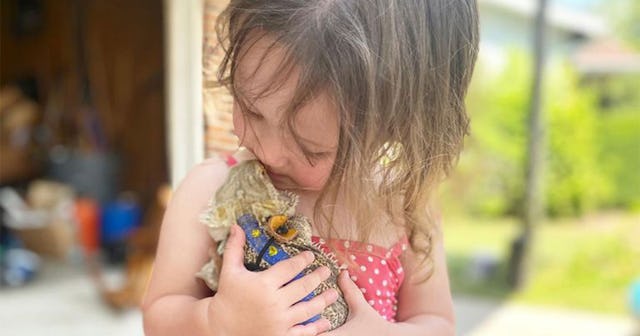We Got A Bearded Dragon, And It Gave Me A Lesson In Grief

Trigger warning: child loss
We came upon her rather unplanned. After losing a beloved turtle last summer, a kind friend offered her bearded dragon. When I mentioned the prospect of another pet, the kids stopped crying and started jumping. Soon after, she was ours.
When we first laid eyes on each other, I squirmed. This animal resembled less the cute stuff of nursery rhymes and more the stuff of things you’d prefer stay underground. Spiky and scaly, she swiveled from side to side like one of Ursula’s assistants. She was poky. And her eyes were on the sides of her face. And she had holes for ears. My husband (hardly a reptile enthusiast) was tasked with bringing her home and setting up the cage. Once finished, he lovingly told me to “keep that velociraptor in the garage.”
Later that day we all stared at her through the glass.
“How should we hold her?” asked the oldest. I squinted. “Let’s Google it.”
“She looks scary,” said the middle one.
“Don’t worry, she’s nice,” I half told/half asked him.
To my astonishment, our youngest walked right up to the glass, opened the door and placed her tiny hands inside. “Come here dragon lizard,” she said, in a singsong voice. “I love you.”
Our first daughter died an ugly way. I don’t mean this to imply that she was ugly, which is farthest from the truth. She had soft little cheeks and dark little waves in her hair. Her ruby red lips were pursed, as though she’d been deep in thought when she passed. She was my husband and she was her brother and she was me. She was the most beautiful thing I’d ever seen.
Courtesy of Nora LaFata
The way she died was ugly. Or perhaps the ugly stems from how we came to hold her: the physical involvement required of me when I did not want any part. The delivery of her body into a world she would never breathe, taste, or smell. The silence of the hospital room. How we scanned its walls for an answer. How they shrugged back at us in beige.
What’s uglier than stillbirth? Than tiny pummels gone soft? What’s uglier than one’s body killing another secretly, while she shops for white lace curtains? Nothing, I thought as I stared down at her, horrified by what I’d just endured.
Seven years later, I can answer.
When Josie died, I was embarrassed and ashamed. I’d taken the vitamins and I’d read the books. I’d skipped the cold cuts and the mimosas and stepped over every crack in the sidewalk. I sang to my abdomen in the shower and I drove the speed limit and I wore flats to work and yet, one exceptionally sunny afternoon, she died. On my watch from something my own body did to her, while birds sang outside.
Unfortunately, society only affirmed my newfound self-hatred:
This never happens. You did x,y, and z, so how did this happen? This is an anomaly.
This is extremely rare. This shouldn’t have happened.
While this seemed to reassure every well-intentioned person around me, there was one glaring problem. It did happen. To me.
So I tried my best to dress it down. I smiled and laughed and wore lipstick. When asked, I told friends we were okay, looking forward, moving forward. And when the scared, pregnant, acquaintance asked what she should “look for,” I repeated all I’d heard. Don’t worry. What happened to me is rare.
It lives in a cage you can lock. That year I’d go home to fold the whites or play catch outside with my son, and when I stopped to breathe my insides lurched. Liar.
Months passed before I could say she died out loud. There was a T-ball game, a nice lady who asked about siblings. “Our daughter was stillborn four months ago,” I said, the words dripping scales on the grass. Her shoulders fell, and my husband looked at his shoes. The ground shifted and I exhaled deeply. Because that is what happens when you tell the truth.
Babies die, sometimes without warning or reason. You can do all the things and plan and pre-register but you don’t hold the reins, and you never have. I think that’s what’s scariest about knowing me, because you have to know that too.
People turn away from the pictures and the proof, but the ugly doesn’t live in the parts they can touch. It wasn’t the howling as we held her that morning, or the blood pools beneath her skin the day after. The ugly isn’t the phantom kicks I felt for weeks, or the tender way we sowed her ashes in the ground. There is strength, there is love, there is beauty in all of that.
The ugly lives in the after. It festers in the “never me,” the walking past. The ugly is never what’s in the cage. The ugly is our refusal to open it.
So we hold things now, when we’re afraid. We let them out, let them writhe in our hands. We allow the distortions of daylight and space, in our walls and on our tongues. We cradle the ugly, all scaly and imperfect and alive; until we can speak it, until we can own it, until it isn’t scary anymore.
We carry the ugly until it’s upstanding, until it becomes something beautiful and familiar. Something worth growing, worth loving, worth roaring for.
This article was originally published on